2. 重庆师范大学 GIS应用研究重点实验室, 重庆 401331
2. Key Laboratory of GIS Application Research, Chongqing Normal University, Chongqing 401331, China
土壤是陆地生态系统的重要组成部分, 也是人类生存和发展的重要基础, 在生态系统中起着重要的物质交换作用[1].据文献[2, 3], 我国城市、城郊和农村均存在不同程度的土壤重金属污染问题, 涉及我国83.9%的省份和22.5%的地级市.由于重金属具有难降解、易累积和持久性等特征[4], 土壤重金属污染会改变土壤的理化性质, 破坏生态环境, 甚至导致灾难性的环境问题[3].此外, 土壤重金属也会通过食物链被人体吸收和积累, 危害人体健康[5, 6].因此, 土壤重金属污染所带来的环境问题日益受到学者和政府部门的重视.
自然因素和人为因素通过直接或间接过程影响土壤重金属累积及其污染的空间分异[1, 7].自然状况下, 成土母岩是土壤重金属的主要来源, 可决定土壤重金属含量、富集[8, 9], 如:震旦纪和寒武纪黑色岩系发育的土壤As和Cd含量较高[9]; 但随着成土过程加深, 土壤性质对重金属富集逐渐增强, 如:广西喀斯特区土壤Cd污染[1, 9].随着社会经济发展, 人类活动对土壤重金属含量影响增强[1, 3, 10].农业活动是人类活动的主要表现[10], 其主要通过化肥和农药等直接增加土壤重金属含量, 或间接改变土壤pH和有机质含量等影响土壤重金属含量累积和空间分布[10, 11].
四川盆地是我国重要的农耕区[12, 13].有研究报道了四川盆地西部土壤中Cd、Cu和Zn等含量分布特征[7], 但四川盆地富硒土壤中重金属含量富集、污染特征及其影响因素研究尚不清晰.为此, 以重庆市的粮食主产区且土壤富硒的江津区为研究区[14], 以土壤中Cd、Cr、Cu、Ni、Pb和Zn为研究对象, 综合运用污染指数法、GIS及地理探测器等分析方法, 研究土壤重金属含量分布、污染特征及其影响因素.其具体研究目标为:①明确重庆市江津区表层土壤中6种重金属含量分布和污染特征; ②厘清表层土壤重金属含量分布差异的关键影响因素.以期为区域生态环境风险评价、区域土壤污染防治和人体健康风险管控等提供理论依据和基础数据.
1 材料与方法 1.1 研究区概况江津区位于重庆市西南部(图 1), 年均气温18.4℃, 年均降水量1 001 mm[15, 16].地形以山地和丘陵为主, 地势由南北向长江河谷降低[图 2(d)][15].
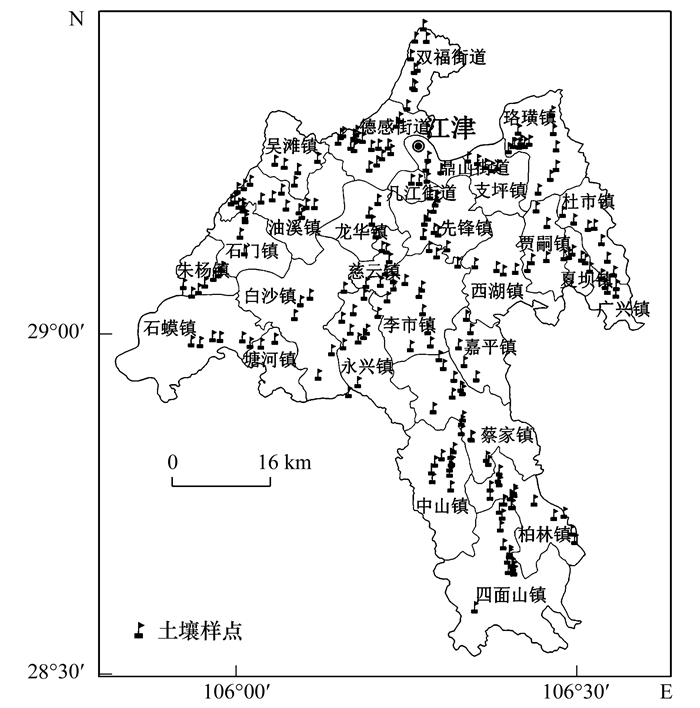
|
图 1 研究区域及采样示意 Fig. 1 Map for soil sampling sites in study area |
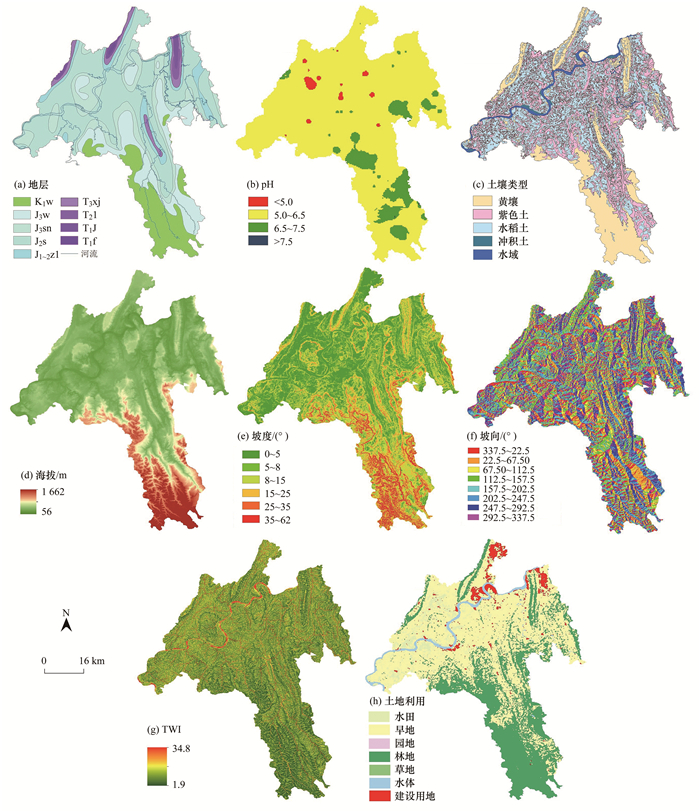
|
图 2 研究区土壤重金属影响因素空间分布 Fig. 2 Spatial distribution of influencing factors of soil heavy metals in the study area |
地质构造上, 研究区位于“川东褶皱”与“川黔南北构造带”过渡带[17].白垩纪地层岩性以砂岩为主, 分布于研究区南部的倒置中低山区; 侏罗纪地层岩性以泥岩为主, 主要分布于中部丘陵地带; 早中三叠世地层岩性为砂质页岩和深灰色灰岩, 三叠纪晚期地层岩性为碎屑岩, 分布于北部背斜低山区[图 2(a)][14].土壤类型有水稻土、紫色土、黄壤和冲积土等[图 2(c)][15, 18].
1.2 样品采集和室内分析以地层为采样单元, 兼顾土地利用方式, 采集表层土壤样品247件(图 1), 其中水田41件、旱地121件、园地18件、林地57件和草地10件.样品在室内自然风干, 剔除土壤中植物根系、小碎石等杂质, 研磨棒打碎土壤团块, 过2.0 mm孔径筛(10目), 研磨至0.149 mm(100目)待测.氢氟酸、浓硝酸和高氯酸消解土壤样品, 电感耦合等离子体光谱仪(ICP-OES)测定土壤中Cd、Cr、Cu、Ni、Pb和Zn含量[19].超纯水为浸提液(水: 土=2.5 : 1), 采用玻璃电极法测定土壤pH[20].本实验过程中, 使用两组空白样, 两组土壤标准物质(GSS-1、GSS-3或GSS-6)与样品同时消解和分析测试, 以控制实验质量.
1.3 影响因素获取依据土壤发育过程理论, 结合研究区地理环境, 选取地层、土壤性质(pH和土壤类型)、地形因素[海拔、坡度、坡向、TWI(地形湿度指数)]和土地利用等8个环境因子(图 2).地层数据源自1:20万地质图; 海拔和土地利用数据源自野外现场调查.坡度、坡向和TWI基于30 m分辨率数字高程模型(DEM)提取.土壤类型数据(源自http://data.ess.tsinghua.edu.cn/)经裁剪和提取后获取.
1.4 研究方法 1.4.1 污染指数法污染指数法用于评价研究区土壤重金属污染状况[21~23].土壤环境质量标准采用农用地土壤污染风险筛选值[24].单因子污染指数(Pi)分级标准为:Pi≤1无污染; 1 < Pi≤2轻污染; 2 < Pi≤3中污染; Pi>3重污染[21]. 内梅罗综合污染指数(NPI)分级标准为:NPI≤0.7清洁(安全); 0.7 < NPI≤1.0尚清洁(警戒线); 1.0 < NPI≤2.0轻污染; 2.0 < NPI≤3.0中污染; NPI>3.0重污染[22, 23].
1.4.2 地理探测器地理探测器(geodetector)是基于空间分异理论的空间关联探测模型[25, 26].本文主要运用因子探测器和交互探测器2个子模块定量识别土壤重金属空间分异的关键影响因子及不同地理因子对土壤重金属空间分异的交互影响.各地理因子重分类见表 1.
|
|
表 1 研究区影响因子重分类 Table 1 Research area impact factor reclassification |
1.4.3 数据处理
Excel 2013用于土壤重金属含量数据统计.ArcGIS 10.2用于提取地理因子和分析土壤重金属空间分布.OriginLab 2019和CorelDRAW X7用于制图.
2 结果与分析 2.1 土壤重金属含量特征研究区表层土壤pH为4.06~7.92, 算术均值(均值, 下同)6.06, 呈弱酸性.研究区6种重金属元素的含量均值分别为Cd(0.27 mg·kg-1)、Cr(60.5 mg·kg-1)、Cu(26.8 mg·kg-1)、Pb(22.4 mg·kg-1)、Ni(25.9 mg·kg-1)和Zn(166 mg·kg-1).Cr、Ni和Pb含量均值低于渝西土壤背景值[32], 而Cd、Cu和Zn含量均值分别为渝西土壤背景值的1.22、1.10和1.98倍, 但与中国土壤背景值[33]相比, Cd、Cu和Zn含量均值是其2.45、1.37和2.96倍.以上表明, 研究区土壤部分重金属具有一定程度的富集现象, 尤其是Cd和Zn.
变异系数(CV)反映土壤重金属空间变异程度, CV值越大则土壤重金属分布越不均匀[7, 34, 35]. Zn、Cd和Cu属于高度变异水平(CV>36%)(表 2), Pb、Cr和Ni属于中度变异水平(16%<CV<36%), 表明研究区土壤重金属受到一定程度人为活动干扰.
|
|
表 2 研究区表层土壤重金属含量统计1) Table 2 Statistics of heavy metal content in surface soil of the study area |
2.2 土壤重金属空间分布特征
整体上, 研究区鼎山街道、德感街道和石门镇土壤重金属含量较高, 南部四面山镇和中山镇土壤重金属含量较低(图 3).具体来看, Cd和Cu在研究区西北部和中部存在局部偏高现象, 其他区域含量较低[图 3(a)和3(c)]. Cr和Ni在研究区南部和东部含量相对较低, 其他区域含量较高, 最高值位于德感街道[图 3(b)和3(d)]. Pb和Zn在研究区北部与西部存在局部含量偏高, 而其他区域含量较低[图 3(e)和3(f)].
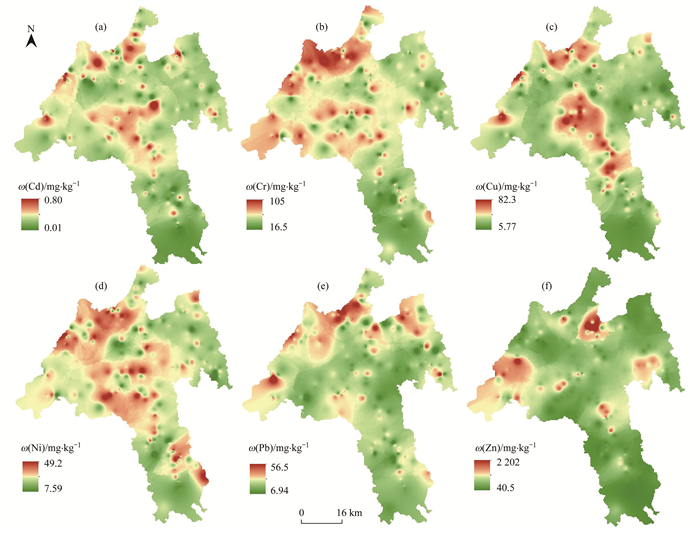
|
图 3 研究区土壤重金属空间分布 Fig. 3 Spatial distribution of soil heavy metals in the study area |
Pi评价结果如图 4所示, 研究区6种重金属元素的Pi均值分别为: Cd(0.89)、Zn(0.80)、Cu(0.47)、Cr(0.38)、Ni(0.35)和Pb(0.25).研究区土壤Cd、Zn和Cu分别有29.6%、21.5%和1.62%样点超过安全线(Pi>1), 其中Zn有3个重度污染点, Cd和Zn元素分别存在4个和10个中度污染点, Cd、Zn和Cu元素分别存在69个、40个和4个轻度污染点.Cr、Ni和Pb全部样点无污染.
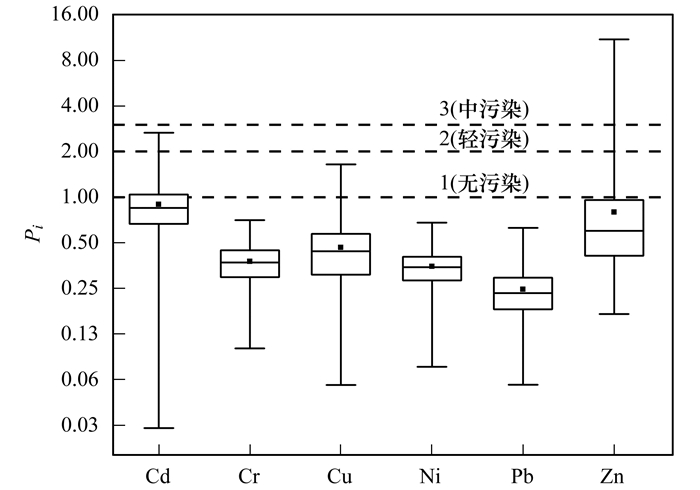
|
图 4 研究区土壤重金属Pi评价 Fig. 4 Evaluation of soil heavy metal Pi in the study area |
NPI评价结果如图 5所示, 研究区安全和警戒样点占比76.92%, 轻度污染样点占比21.46%, 中度污染样点占比1.21%, 重度污染样点占比0.40%.整体上, NPI空间分布呈现西北高、东南低, 东部和南部污染指数多为安全或警戒.NPI最高值位于研究区北部的几江、鼎山和德感这3个街道的交界处, 最低值位于研究区南部的四面山镇.
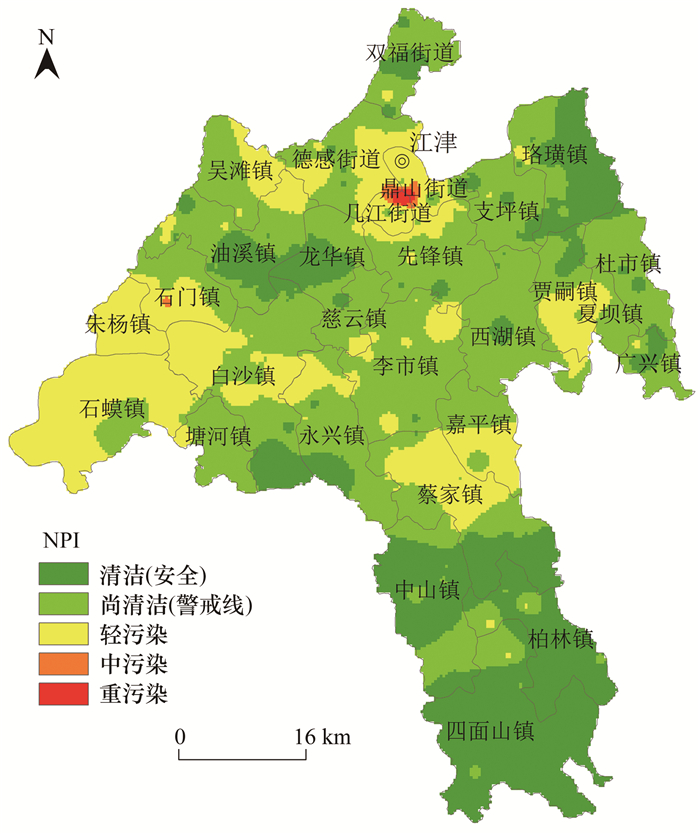
|
图 5 研究区土壤重金属NPI空间分布 Fig. 5 Spatial distribution of soil heavy metal NPI in the study area |
因子探测结果表明(图 6), 海拔、地层和土壤pH对Cd解释力较强; 地层、坡度和TWI对Cr的解释力较强; 地层、坡向和海拔对Cu的解释力较强; 地层、坡向和土壤类型对Ni的解释力较强; 地层、海拔和坡向对Pb的解释力较强; 地层、TWI和海拔对Zn的解释力较强.
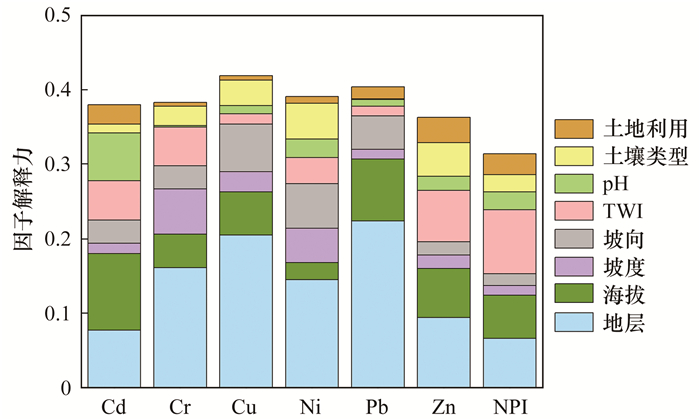
|
图 6 研究区不同地理因子对土壤重金属的解释力 Fig. 6 Explanatory power of different geographical factors on soil heavy metals in the study area |
交互探测结果显示(图 7), 两两因子交互后均为非线性增强.其中, 地层和TWI对研究区NPI的交互作用最强, 其次是TWI和坡向.地层和坡向的交互作用对Cd和Ni的影响最强, 地层和TWI的交互作用对Cr和Zn的影响最强, 海拔和地层的交互作用对Cu和Pb的影响最强.以上表明研究区土壤重金属累积受多种成土因素交互影响.
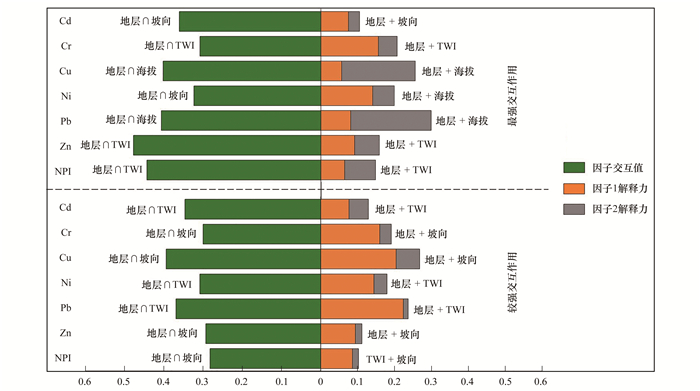
|
图 7 研究区两两地理因子对土壤重金属交互探测结果 Fig. 7 Interaction detection results of soil heavy metals by two geographic factors in the study area |
成土母岩是土壤重金属的自然来源[1, 8].研究区不同地层上发育的表层土壤重金属含量均值见图 8, 出露于三叠系的表层土壤Cd、Cr、Cu、Ni和Pb元素含量最高; 侏罗系发育土壤呈现Zn含量略高于三叠系; 白垩系发育土壤重金属含量最低.地理探测器结果显示(图 6和图 7), 地层对Cr、Cu、Ni、Pb和Zn的解释力最强, 地层与其他影响因子的交互作用对土壤Cd、Cr、Cu、Ni、Pb和Zn等元素的影响最强, 这表明研究区土壤重金属含量分布主要受控于成土母岩.
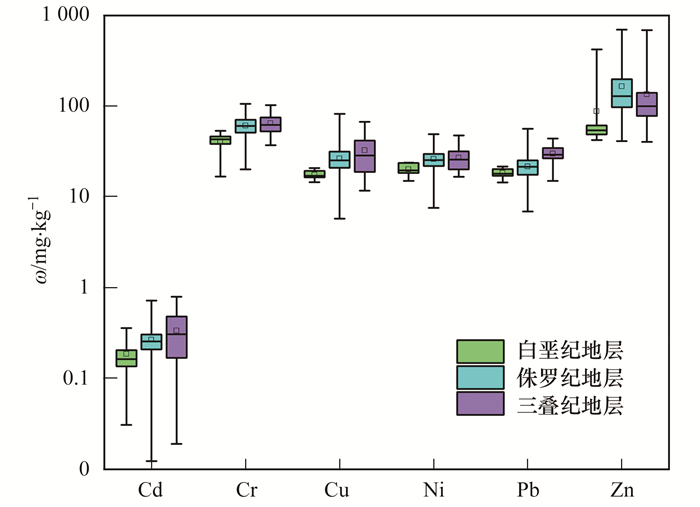
|
重金属通过Kraskal-Wallis非参数检验(P<0.05) 图 8 不同地层单元表层土壤重金属含量 Fig. 8 Contents of heavy metal soils in different stratigraphic region |
自然状况下, 土壤化学成分受控于成土母岩[8, 14, 36].研究区三叠纪地层岩性以浅海相灰岩和深湖相泥质岩为主[37], 发育的表层土壤中黏土矿物和有机质含量较高[13, 38], 对风化产物中重金属具有较强富集作用, 因此三叠纪地层发育土壤中Cd、Cr、Cu、Ni和Pb等重金属相对富集.侏罗系沉积环境属于湖河相泥岩和粉砂岩沉积[12, 37, 38], 风化后黏土矿物含量较高, 导致土壤中易富集Cd、Cr、Cu、Ni和Pb等元素.白垩纪地层岩性以砂岩为主[12], 砂岩风化形成的土壤颗粒较大、组织疏松并多含石英砂粒, 土壤偏砂质, 导致重金属淋失较快, 不易富集[12, 38, 39].因此, 研究区地层岩性物理和化学成分的差异导致了其发育土壤中重金属含量差异.
3.2 地形因子对表土中重金属的影响因子探测器结果显示(图 6), 海拔对土壤Cd元素的单因子解释力为0.103, 为最高解释力水平.除了Cd, 地形因子对其它重金属元素的解释力仅次于地层.交互探测器结果显示(图 7), 地形因子与地层的交互作用对土壤Cd、Cr、Cu、Ni、Pb和Zn等元素影响最强.
地形可通过影响水热分布, 间接调控土壤基本理化性质而影响土壤重金属含量分布[20, 40].地理探测器结果显示(图 6和图 7), 海拔和坡度对各重金属含量的影响较大.皮尔逊相关性分析结果显示(未列表), 海拔与Cd、Cr、Cu和Zn呈极显著负相关关系(P<0.01), 坡度与Cr呈极显著负相关关系(P<0.01), 坡度与Cu和Zn呈显著负相关关系(P<0.05).随着海拔和坡度的升高, 土壤重金属的含量会明显降低.这可能是因为研究区位于西南地区, 降水较多, 高海拔和陡坡区域降水丰沛, 土壤侵蚀较严重, 导致重金属易淋失迁移至中低海拔平缓处累积下来[41].
3.3 pH和土壤类型对表土中重金属的影响土壤pH是重要的土壤理化性质, 土壤pH间接影响土壤重金属形态和价态, 从而导致重金属迁移和富集[40].地理探测器结果显示(图 6和图 7), pH对Cd元素的解释力为0.064.皮尔逊相关性分析结果显示(未列表), 土壤pH值与Cd和Ni呈极显著正相关(P<0.01), 与Cu呈显著正相关(P<0.05), 与Cr、Pb和Zn无显著相关性.这可能是因为土壤pH值升高会促进土壤胶体和黏粒对重金属离子的吸附, 且土壤pH是影响Cd吸附的关键因子, 随土壤pH增加Cd的吸附能力增强[2, 40].
土壤类型是土壤理化性质的综合体现[41].地理探测器结果显示(图 6和图 7), 土壤类型对Ni元素的解释力为0.048, 处于较强水平, 对其他重金属含量影响较小, 这可能是因为Ni在黄壤等酸性土壤中, 易于溶解和迁移[20, 42], 研究区黄壤主要分布在北部和南部中低山区, 山区坡度较大, Ni进一步淋失, 不易积累.
3.4 土地利用方式对表土中重金属的影响土地利用方式是人为活动的重要体现形式, 其通过影响土壤理化性质而间接影响土壤重金属富集和迁移[43, 44].地理探测器结果显示(图 6和图 7), 土地利用对研究区土壤重金属含量影响较小.单因素方差分析结果表示, 土地利用差异对土壤重金属含量无统计学意义(P>0.05).曹淑珍等研究发现工矿业活动和农药化肥的不合理施用可能是造成农用土壤重金属含量较高的主要原因[15, 18], 农药化肥中通常含有Cd和Cr等重金属元素, 长期施用的过程中农用土壤会不断富集重金属[45, 46].
4 结论(1) 研究区表层土壤Cd、Cu和Zn含量均值分别是渝西地区土壤背景值的1.22、1.10和1.98倍.
(2) 研究区北部、西部和中部地区土壤重金属含量较高, 东部和南部地区含量较低.NPI最高值位于北部鼎山街道, 最低值位于南部四面山镇, 均值为0.866, 污染样点占总样点的22.1%.
(3) 地层对Cr、Cu、Ni、Pb和Zn的单因子解释力最强, 而海拔对Cd元素的单因子解释力最强.地层与地形因子对土壤重金属的交互作用最强.这些表明, 研究区土壤重金属含量分布主要受控于地层和地形因子.
| [1] | Huang S, Xiao L S, Zhang Y C, et al. Interactive effects of natural and anthropogenic factors on heterogenetic accumulations of heavy metals in surface soils through geodetector analysis[J]. Science of the Total Environment, 2021, 789. DOI:10.1016/j.scitotenv.2021.147937 |
| [2] | Yuan G L, Sun T H, Han P, et al. Source identification and ecological risk assessment of heavy metals in topsoil using environmental geochemical mapping: typical urban renewal area in Beijing, China[J]. Journal of Geochemical Exploration, 2014, 136: 40-47. DOI:10.1016/j.gexplo.2013.10.002 |
| [3] | Zhao L, Xu Y F, Hou H, et al. Source identification and health risk assessment of metals in urban soils around the Tanggu chemical industrial district, Tianjin, China[J]. Science of the Total Environment, 2014, 468-469: 654-662. DOI:10.1016/j.scitotenv.2013.08.094 |
| [4] |
张定熙, 孙涛, 王永敏, 等. 不同长度秸秆还田对土壤汞甲基化与水稻植株甲基汞富集的影响[J]. 环境化学, 2019, 38(7): 1488-1496. Zhang D X, Sun T, Wang Y M, et al. Effect of straw returning with different lengths on mercury methylation in paddy soil and methylmercury accumulation in rice plants[J]. Environmental Chemistry, 2019, 38(7): 1488-1496. |
| [5] |
张鹏岩, 秦明周, 陈龙, 等. 黄河下游滩区开封段土壤重金属分布特征及其潜在风险评价[J]. 环境科学, 2013, 34(9): 3654-3662. Zhang P Y, Qin M Z, Chen L, et al. Study on distribution characteristics and potential ecological risk of soil heavy metals in the Yellow River beach region in Kaifeng City[J]. Environmental Science, 2013, 34(9): 3654-3662. |
| [6] |
陈洁, 王娟, 王怡雯, 等. 影响不同农作物镉富集系数的土壤因素[J]. 环境科学, 2021, 42(4): 2031-2039. Chen J, Wang J, Wang Y W, et al. Influencing factors of cadmium bioaccumulation factor in crops[J]. Environmental Science, 2021, 42(4): 2031-2039. |
| [7] |
张丁, 黄容, 高雪松. 山地平原过渡带耕地土壤重金属空间特征及潜在生态风险因素探析[J]. 环境科学, 2022, 43(2): 946-956. Zhang D, Huang R, Gao X S. Spatial characteristics and potential ecological risk factors of heavy metals in cultivated land in the transition zone of a mountain plain[J]. Environmental Science, 2022, 43(2): 946-956. |
| [8] | Lv J S, Wang Y M. Multi-scale analysis of heavy metals sources in soils of Jiangsu Coast, Eastern China[J]. Chemosphere, 2018, 212: 964-973. DOI:10.1016/j.chemosphere.2018.08.155 |
| [9] |
马宏宏, 彭敏, 刘飞, 等. 广西典型碳酸盐岩区农田土壤-作物系统重金属生物有效性及迁移富集特征[J]. 环境科学, 2020, 41(1): 449-459. Ma H H, Peng M, Liu F, et al. Bioavailability, translocation, and accumulation characteristic of heavy metals in a soil-crop system from a typical carbonate rock area in Guangxi, China[J]. Environmental Science, 2020, 41(1): 449-459. |
| [10] | Chi Y, Shi H H, Zheng W, et al. Simulating spatial distribution of coastal soil carbon content using a comprehensive land surface factor system based on remote sensing[J]. Science of the Total Environment, 2018, 628-629: 384-399. DOI:10.1016/j.scitotenv.2018.02.052 |
| [11] | Sun L, Carey M, Yang L, et al. Source identification of trace elements in peri-urban soils in eastern China[J]. Exposure and Health, 2019, 11(3): 195-207. DOI:10.1007/s12403-018-0290-1 |
| [12] |
程强, 寇小兵, 黄绍槟, 等. 中国红层的分布及地质环境特征[J]. 工程地质学报, 2004, 12(1): 34-40. Cheng Q, Kou X B, Huang S B, et al. The distributes and geologic environment characteristics of red beds in China[J]. Journal of Engineering Geology, 2004, 12(1): 34-40. DOI:10.3969/j.issn.1004-9665.2004.01.007 |
| [13] |
王锐, 邓海, 严明书, 等. 重庆市酉阳县南部农田土壤重金属污染评估及来源解析[J]. 环境科学, 2020, 41(10): 4749-4756. Wang R, Deng H, Yan M S, et al. Assessment and source analysis of heavy metal pollution in farmland soils in southern Youyang County, Chongqing[J]. Environmental Science, 2020, 41(10): 4749-4756. |
| [14] | Liu Y L, Tian X L, Liu R, et al. Key driving factors of selenium-enriched soil in the low-Se geological belt: a case study in Red Beds of Sichuan Basin, China[J]. CATENA, 2021, 196. DOI:10.1016/j.catena.2020.104926 |
| [15] |
曹淑珍, 母悦, 崔敬鑫, 等. 稻田土壤Cd污染与安全种植分区: 以重庆市某区为例[J]. 环境科学, 2021, 42(11): 5535-5544. Cao S Z, Mu Y, Cui J X, et al. Cd pollution and safe planting zoning in paddy soils: A case study in a district of Chongqing[J]. Environmental Science, 2021, 42(11): 5535-5544. |
| [16] |
周皎, 何欣芮, 李瑜, 等. 基于土壤重金属特征的绿色食品产地环境评价——以重庆(江津)现代农业园区为例[J]. 中国环境科学, 2020, 40(7): 3070-3078. Zhou J, He X R, Li Y, et al. Evaluation of soil environmental quality in green food production based on spatial distribution of heavy metals—a case study of modern agricultural park in Iiangjin district, Chongqing[J]. China Environmental Science, 2020, 40(7): 3070-3078. DOI:10.3969/j.issn.1000-6923.2020.07.033 |
| [17] | Yuan Y Y, Liu Y L, Luo K L, et al. Hydrochemical characteristics and a health risk assessment of the use of river water and groundwater as drinking sources in a rural area in Jiangjin District, China[J]. Environmental Earth Sciences, 2020, 79(7). DOI:10.1007/s12665-020-8900-1 |
| [18] |
赵婉彤. 重庆市江津区土壤硒含量分布及影响因素的研究[D]. 重庆: 西南大学, 2015. Zhao W T. Study on the distribution and influencing factors of soil Se of Jiangjin district, Chongqing municipality[D]. Chongqing: Southwest University, 2015. |
| [19] | HJ 803-2016, 土壤和沉积物12种金属元素的测定王水提取-电感耦合等离子体质谱法[S]. |
| [20] | Shen Z J, Xu D C, Li L L, et al. Ecological and health risks of heavy metal on farmland soils of mining areas around Tongling City, Anhui, China[J]. Environmental Science and Pollution Research, 2019, 26(15): 15698-15709. DOI:10.1007/s11356-019-04463-0 |
| [21] |
吕悦风, 孙华. 浙北某县域耕地土壤重金属空间分异特征、污染评价及来源分析[J]. 农业环境科学学报, 2019, 38(1): 95-102. Lv Y F, Sun H. Spatial differentiation characteristics, pollution evaluation, and source analysis of heavy metals in farmland soil in a county in northern Zhejiang Province, China[J]. Journal of Agro-Environment Science, 2019, 38(1): 95-102. |
| [22] |
宁晓波, 项文化, 方晰, 等. 贵阳花溪区石灰土林地土壤重金属含量特征及其污染评价[J]. 生态学报, 2009, 29(4): 2169-2177. Ning X B, Xiang W H, Fang X, et al. Heavy metal concentrations and pollution assessment of limestone forests in Huaxi district, Guiyang City[J]. Acta Ecologica Sinica, 2009, 29(4): 2169-2177. |
| [23] | 许桂苹, 王晓飞, 付洁. 土壤重金属污染评价方法研究综述[J]. 农村经济与科技, 2014, 25(1): 71-74. |
| [24] | GB 15618-2018, 土壤环境质量农用地土壤污染风险管控标准(试行)[S]. |
| [25] |
王劲峰, 徐成东. 地理探测器: 原理与展望[J]. 地理学报, 2017, 72(1): 116-134. Wang J F, Xu C D. Geodetector: principle and prospective[J]. Acta Geographica Sinica, 2017, 72(1): 116-134. |
| [26] | Tao H, Liao X Y, Li Y, et al. Quantifying influences of interacting anthropogenic-natural factors on trace element accumulation and pollution risk in karst soil[J]. Science of the Total Environment, 2020, 721. DOI:10.1016/j.scitotenv.2020.137770 |
| [27] | 四川省地质矿产局. 四川省区域地质志[M]. 北京: 地质出版社, 1991. |
| [28] | SL 190-2007, 土壤侵蚀分类分级标准[S]. |
| [29] | DZ/T 0295-2016, 土地质量地球化学评价规范[S]. |
| [30] | GB/T 17296-2009, 中国土壤分类与代码[S]. |
| [31] | GB/T 21010-2017, 土地利用现状分类[S]. |
| [32] |
鲍丽然, 龚媛媛, 严明书, 等. 渝西经济区土壤地球化学基准值与背景值及元素分布特征[J]. 地球与环境, 2015, 43(1): 31-40. Bao L R, Gong Y Y, Yan M S, et al. Element geochemical baseline and distributions in soil in Chongqing west economic zone, China[J]. Earth and Environment, 2015, 43(1): 31-40. |
| [33] |
鄢明才, 顾铁新, 迟清华, 等. 中国土壤化学元素丰度与表生地球化学特征[J]. 物探与化探, 1997, 21(3): 161-167. Yan M C, Gu T X, Chi Q H, et al. Abundance of chemical elements of soils in China and supergenesis geochemistry characteristics[J]. Geophysical and Geochemical Exploration, 1997, 21(3): 161-167. |
| [34] |
刘永林, 雒昆利, 袁余洋. 重庆市江津区表层土壤中稀土元素含量与分布特征[J]. 中国稀土学报, 2020, 38(2): 215-224. Liu Y L, Luo K L, Yuan Y Y. Content and spatial distribution characteristics of rare earth of surface soil in Jiangjin district, Chongqing city[J]. Journal of the Chinese Society of Rare Earths, 2020, 38(2): 215-224. |
| [35] |
赖书雅, 董秋瑶, 宋超, 等. 南阳盆地东部山区土壤重金属分布特征及生态风险评价[J]. 环境科学, 2021, 42(11): 5500-5509. Lai S Y, Dong Q Y, Song C, et al. Distribution characteristics and ecological risk assessment of soil heavy metals in the eastern mountainous area of the Nanyang Basin[J]. Environmental Science, 2021, 42(11): 5500-5509. |
| [36] | Świdwa-Urbańska J, Batlle-Sales J. Data quality oriented procedure, for detailed mapping of heavy metals in urban topsoil as an approach to human health risk assessment[J]. Journal of Environmental Management, 2021, 295. DOI:10.1016/j.jenvman.2021.113019 |
| [37] |
贾中民. 渝西北土壤重金属污染特征、源解析与生态健康风险评价[D]. 重庆: 西南大学, 2020. Jia Z M. Characteristics, source apportionment, and ecological health risk assessment of soil heavy metals contamination in Northwest Chongqing[D]. Chongqing: Southwest University, 2020. |
| [38] |
李艳, 张薇薇, 程永毅, 等. 重庆紫色母岩及土壤As、Hg环境地球化学基线研究[J]. 土壤学报, 2017, 54(4): 917-926. Li Y, Zhang W W, Cheng Y Y, et al. Environmental geochemical baseline of As and Hg in purple soil and its parent rock in Chongqing[J]. Acta Pedologica Sinica, 2017, 54(4): 917-926. |
| [39] |
廖德平, 龙启德. 贵州林业土壤[J]. 贵州林业科技, 1997, 25(4): 1-66. Liao D P, Long Q D. The soils for forestry in Guizhou[J]. Guizhou Forestry Science and Technology, 1997, 25(4): 1-66. |
| [40] |
成杭新, 彭敏, 赵传冬, 等. 表生地球化学动力学与中国西南土壤中化学元素分布模式的驱动机制[J]. 地学前缘, 2019, 26(6): 159-191. Cheng H X, Peng M, Zhao C D, et al. Epigenetic geochemical dynamics and driving mechanisms of dis-tribution patterns of chemical elements in soil, Southwest China[J]. Earth Science Frontiers, 2019, 26(6): 159-191. |
| [41] | Gou Y, Wei J, Li J L, et al. Estimating purple-soil moisture content using Vis-NIR spectroscopy[J]. Journal of Mountain Science, 2020, 17(9): 2214-2223. |
| [42] |
常同举, 崔孝强, 阮震, 等. 长期不同耕作方式对紫色水稻土重金属含量及有效性的影响[J]. 环境科学, 2014, 35(6): 2381-2391. Chang T J, Cui X Q, Ruan Z, et al. Long-term effects of tillage methods on heavy metal accumulation and availability in purple paddy soil[J]. Environmental Science, 2014, 35(6): 2381-2391. |
| [43] | Rao K, Tang T, Zhang X, et al. Spatial-temporal dynamics, ecological risk assessment, source identification and interactions with internal nutrients release of heavy metals in surface sediments from a large Chinese shallow lake[J]. Chemosphere, 2021, 282. DOI:10.1016/j.chemosphere.2021.131041 |
| [44] |
王乔林, 宋云涛, 王成文, 等. 滇西地区土壤重金属来源解析及空间分布[J]. 中国环境科学, 2021, 41(8): 3693-3703. Wang Q L, Song Y T, Wang C W, et al. Source identification and spatial distribution of soil heavy metals in Western Yunnan[J]. China Environmental Science, 2021, 41(8): 3693-3703. |
| [45] |
胡杰, 赵心语, 王婷婷, 等. 太原市汾河河岸带土壤重金属分布特征、评价与来源解析[J]. 环境科学, 2022, 43(5): 2500-2509. Hu J, Zhao X Y, Wang T T, et al. Distribution characteristics, evaluation, and source analysis of heavy metals in soils of Fenhe riparian zone in Taiyuan City[J]. Environmental Science, 2022, 43(5): 2500-2509. |
| [46] |
夏子书, 白一茹, 王幼奇, 等. 基于PMF模型的宁南山区小流域土壤重金属空间分布及来源解析[J]. 环境科学, 2022, 43(1): 432-441. Xia Z S, Bai Y R, Wang Y Q, et al. Spatial distribution and source analysis of soil heavy metals in a small watershed in the mountainous area of southern Ningxia based on PMF model[J]. Environmental Science, 2022, 43(1): 432-441. |
 2023, Vol. 44
2023, Vol. 44


